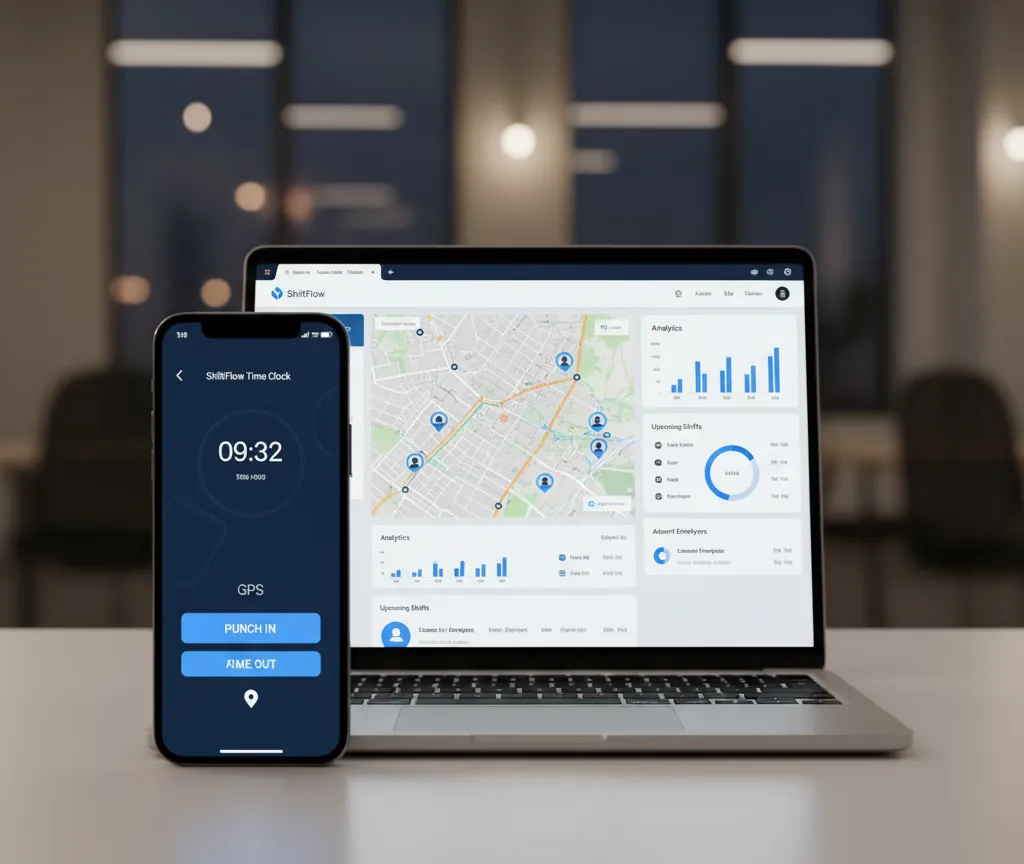· ShiftFlow Editorial Team · Glossary · 7 min read
What Is 3rd Shift? Definition, Examples & Guide
Learn what third shift means, typical 3rd shift hours (11 PM–7 AM), the difference between 1st, 2nd, and 3rd shifts, night shift pay differentials, health impacts, and how to find third shift jobs. Expert guide for workers and managers.

What is Third Shift?
Third shift (also called night shift, graveyard shift, or overnight shift) is the overnight work schedule in 24-hour operations. Standard third shift hours run from 11 PM to 7 AM, though some businesses use 10 PM–6 AM or midnight–8 AM.
1st, 2nd, and 3rd shifts visualized across 24 hours
The difference between 1st shift, 2nd shift, and 3rd shift is timing: first shift covers morning (7 AM–3 PM), second shift covers evening (3 PM–11 PM), and third shift covers overnight when most people sleep.
In Short
Third shift hours are typically 11 PM–7 AM. Workers earn 10–25% night shift differential pay but face circadian rhythm disruption. Common third shift jobs include healthcare, manufacturing, warehousing, and security. Success requires consistent sleep schedules, proper lighting, and employer health support. As of 2025, the most recent Bureau of Labor Statistics American Time Use Survey data available (2017–2018) shows roughly 9 million U.S. wage and salary workers regularly rotate through night shifts.
Health and safety guidance reviewed by workforce management specialists with expertise in shift work physiology and occupational health compliance.
Common Night Shift Terminology
- Night shift
- Graveyard shift
- Overnight shift
- Third watch
- Midnight shift
Difference Between 1st, 2nd, and 3rd Shift
| Shift Type | Typical Hours | Peak Industries | Pay Differential |
|---|---|---|---|
| 1st Shift | 7 AM–3 PM | Office, retail, construction | None |
| 2nd Shift | 3 PM–11 PM | Manufacturing, hospitality | 5–15% extra |
| 3rd Shift | 11 PM–7 AM | Healthcare, security, logistics | 10–25% extra |
| Rotating | All hours | Emergency services, utilities | Varies by shift |
Third Shift Jobs: Industries Hiring Overnight Workers
About 9 million U.S. wage and salary workers regularly work night or rotating shifts, according to the most recent Bureau of Labor Statistics American Time Use Survey data available as of 2025 (2017–2018 release, Table 7). Healthcare, security, and construction businesses rely heavily on overnight staffing:

| Industry | 3rd shift workers (approx.) | Typical differential | Primary overnight activities |
|---|---|---|---|
| Education & health services | 2.1 million | 15–20% | Emergency care, patient monitoring |
| Wholesale & retail trade | 1.9 million | 5–12% | Stocking, overnight customer coverage |
| Manufacturing | 1.2 million | 12–18% | Continuous production, equipment upkeep |
| Leisure & hospitality | 1.0 million | 8–15% | Front desk, kitchen prep, cleaning |
| Transportation & utilities | 800,000 | 10–15% | Freight moves, dispatch, infrastructure response |
| Public administration & protective | 500,000 | 10–15% | Public safety, emergency operations |
| Other services (security, facilities) | 300,000 | 10–15% | Site patrol, facility cleaning |
Source: BLS American Time Use Survey, Table 7 (2017–2018). Counts reflect workers who usually perform night or rotating shifts (rotating teams spend recurring weeks on overnight coverage). This is the latest dataset available as of 2025.
Industries like healthcare, security, and construction use specialized scheduling to manage overnight crews effectively.
Health Impacts of Working Third Shift
Working third shift disrupts your circadian rhythm and increases health risks. According to the CDC NIOSH, night workers face higher rates of:
| Health Category | Specific Risks | Prevalence vs Day Workers | Mitigation Strategies |
|---|---|---|---|
| Sleep Disorders | Insomnia, fragmented sleep, fatigue | 2.5× higher | Blackout curtains, consistent schedule |
| Cardiovascular | Hypertension, heart disease | 1.4× higher | Regular checkups, stress management |
| Metabolic | Type 2 diabetes, obesity | 1.3× higher | Planned meals, limit processed food |
| Mental Health | Depression, anxiety, isolation | 1.6× higher | Social connections, professional support |
| Digestive | GERD, IBS, irregular appetite | 1.8× higher | Small frequent meals, avoid heavy foods |
| Immune Function | More frequent infections, slower recovery | 1.2× higher | Sleep hygiene, vaccination compliance |
| Accident Risk | Drowsiness-related injuries, reduced focus | 1.5× higher | Adequate rest breaks, buddy systems |
How to Stay Healthy on Third Shift
- Sleep: Use blackout curtains, keep consistent sleep times, avoid screens before bed
- Light: Bright lights at work, sunglasses on commute home, dark bedroom
- Food: Light meals, limit caffeine after midnight, avoid heavy foods
- Health: Annual checkups, monitor blood pressure and blood sugar
- Rest: Take breaks every 2–3 hours, limit consecutive nights to 5–7 maximum

Night Shift Differential Pay
Third shift workers earn 10–25% more than day shift base pay through shift differential premiums. Federal law doesn’t require night differentials except for federal contractors (7.5% minimum under the Service Contract Act). Employers must also track hours accurately for overtime calculation—learn more about time tracking best practices.
Pay Examples
- Nurse: $38/hour + 20% = $45.60/hour overnight
- Warehouse Worker: $17/hour + $2/hour = $19/hour overnight
- Manufacturing Tech: $24/hour + 15% = $27.60/hour overnight
- Security Guard: $16/hour + 7.5% = $17.20/hour minimum (federal contracts)
Scheduling Best Practices for 3rd Shift
Rotation vs Fixed Overnight Schedules
| Approach | Description | Advantages | Disadvantages | Best For |
|---|---|---|---|---|
| Fixed Nights | Same team works 3rd shift permanently | Consistent sleep patterns, specialization | Social isolation, health risks | Voluntary night workers |
| Forward Rotation | 1st → 2nd → 3rd progression | Easier circadian adjustment | Complex scheduling | 24/7 operations, fairness |
| Backward Rotation | 1st → 3rd → 2nd progression | N/A | Harder on body, not recommended | Avoid this pattern |
| Slow Rotation | 2–4 weeks per shift | Time to adapt to each shift | Frequent disruption | Manufacturing, utilities |
| Rapid Rotation | 2–3 days per shift | Prevents full circadian adaptation | Constant mild fatigue | Emergency services |
Best Practices
NIOSH research shows:
- Forward rotation (day → evening → night) is easier on the body
- 2–3 week rotations allow partial adjustment
- Post schedules 2–4 weeks ahead to reduce stress
Proper scheduling reduces call-offs and absences while improving team morale.
Common Schedule Examples
- Fixed: Mon–Fri 11 PM–7 AM (permanent night crew)
- Rotating 12-hour: Alternating 3–4 night shifts per week
- DuPont: 4 nights on, 3 off, 3 days on, 1 off, 3 nights on, 3 off, 4 days on, 7 off

Legal Compliance
Key Federal Rules
- Overtime: Time-and-a-half after 40 hours (FLSA)
- Federal Contractors: 7.5% minimum night differential
- Safety: Adequate lighting and fatigue management (OSHA)
State Requirements Vary
- California: Daily overtime after 8 hours, strict meal/rest breaks
- New York: Spread-of-hours pay for 10+ hour shifts
- Oregon: 10-hour rest between shifts required
- Washington/Seattle: Predictive scheduling laws
Keep accurate time records, differential calculations, and break logs for compliance. Digital timesheet solutions simplify overnight pay tracking and ensure regulatory compliance.
Managing Third Shift Teams
Common Challenges
| Challenge | Solutions |
|---|---|
| Limited Supervision | Empower leads, clear protocols, check-ins |
| Communication Gaps | Shift handoff notes, daily briefings |
| Social Isolation | Team events, recognition programs |
| Safety Risks | Buddy systems, adequate lighting, breaks |
Building Strong Teams
- Hire right: Screen for night owls, offer trial periods
- Train well: Pair with mentors, teach health strategies
- Stay connected: Include in company meetings, recognize achievements
- Show up: Leaders should work overnight shifts occasionally
Technology for Overnight Operations
Modern scheduling software helps with:
- Auto-calculating night shift differentials
- Tracking consecutive nights and mandating rest
- Alerting managers to overtime and break violations
- Enabling shift bidding and mobile communication
- 24/7 incident reporting with automatic escalation

Typical ROI for 200 overnight workers: $598k annual value (reduced turnover, overtime, errors) vs. $18k–$35k platform cost. See how ShiftFlow streamlines scheduling for 24-hour operations.
Finding and Keeping Overnight Workers
Attracting Workers
- Pay 15–20% differentials (top quartile locally)
- Highlight perks: Quieter work, less supervision, easier parking
- Offer flexibility: 4×10 schedules instead of 5×8 (see flexible scheduling)
- Show career paths: Advancement from night positions
- Target ads: Students, parents, second-job seekers
Keeping Workers
- Pay competitively (15–20% minimum differential)
- Provide health screenings and wellness resources
- Give equal access to benefits and advancement
- Recognize overnight achievements company-wide
- Allow day shift transfers after 6–12 months
- Build community among night workers
The Bottom Line
Third shift (11 PM–7 AM) offers 10–25% higher pay but disrupts circadian rhythms. Success requires competitive differentials, health support, smart scheduling, and strong management.
Companies that invest in overnight workers see 28% lower turnover and 22% fewer safety incidents.
Ready to optimize your overnight shifts? Explore ShiftFlow’s workforce management platform for 24-hour operations, or check out our free hours calculator to simplify overnight time tracking. Learn more about managing call-offs and flexible scheduling strategies.
Frequently Asked Questions
What is the meaning of third shift?
Third shift is the overnight work schedule (typically 11 PM–7 AM) in 24-hour operations. It’s called “third” because it follows first shift (day, 7 AM–3 PM) and second shift (evening, 3 PM–11 PM).
What are typical 3rd shift hours?
Standard third shift hours are 11 PM to 7 AM. Some businesses use 10 PM–6 AM or midnight–8 AM depending on operational needs.
How much more do 3rd shift workers make?
Night shift differentials range from 10–25% above base pay. Healthcare and manufacturing typically pay 15–20%. Federal contractors must pay at least 7.5%.
Is working 3rd shift bad for your health?
Overnight work disrupts circadian rhythms and increases risks for sleep disorders, heart problems, and metabolic issues. Many workers adapt successfully with consistent sleep schedules, proper lighting, healthy eating, and regular checkups.
Can I switch from 3rd shift to day shift later?
Most companies allow transfers after 6–12 months based on seniority and openings. Discuss transfer policies during hiring.
What industries hire the most third shift workers?
Healthcare, manufacturing, warehousing, transportation, security, hospitality, customer support, and public safety all hire significant overnight workforces.
How do I stay awake during overnight shifts?
Use bright lights at work, take breaks every 2–3 hours, stay hydrated, eat light meals, limit late-shift caffeine, stay active, and maintain consistent sleep schedules on days off.
Are overnight shifts rotating or permanent?
Both exist. Healthcare often rotates to share the burden fairly. Manufacturing often uses permanent crews. Rotating schedules should follow forward rotation (day → evening → night).
Do I get paid more for weekend nights?
Some employers stack weekend premiums on top of night differentials, resulting in 25–35% total above base rates for Saturday/Sunday nights. Policies vary by employer.




